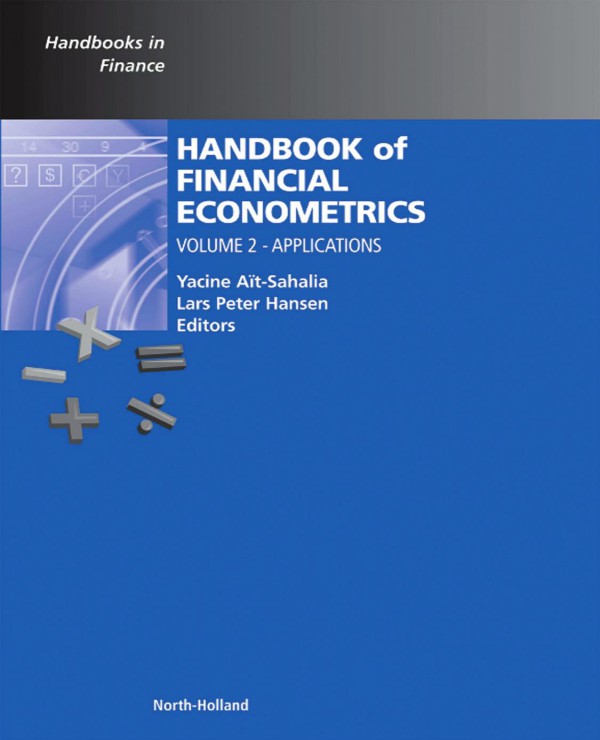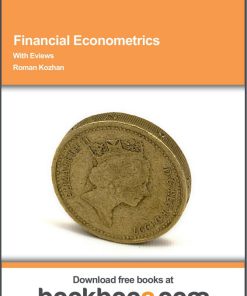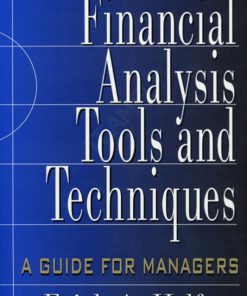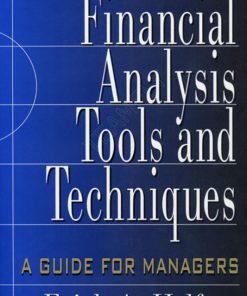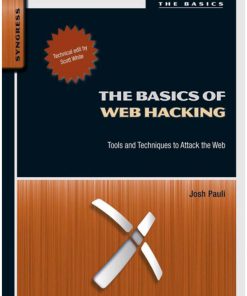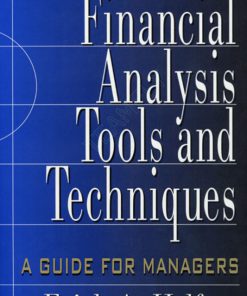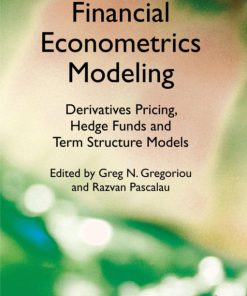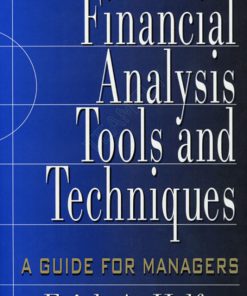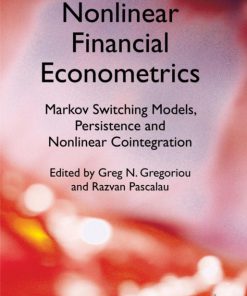Handbook of Financial Econometrics Tools and Techniques 1st edition by Ait Sahalia,Yacine,Hansen,Lars Peter 0080929842 9780080929842
$50.00 Original price was: $50.00.$25.00Current price is: $25.00.
Authors:Ait-Sahalia, Yacine.; Hansen, Lars Peter. , Author sort:Ait-Sahalia, Yacine.; Hansen, Lars Peter. , Languages:Languages:eng , Published:Published:Aug 2009
Handbook of Financial Econometrics Tools and Techniques 1st edition by Ait Sahalia,Yacine,Hansen,Lars Peter – Ebook PDF Instant Download/Delivery.9780080929842,0080929842
Full download Handbook of Financial Econometrics Tools and Techniques 1st edition after payment

Product details:
ISBN 10:0080929842
ISBN 13:9780080929842
Author: Ait Sahalia,Yacine,Hansen,Lars Peter
This collection of original articles—8 years in the making—shines a bright light on recent advances in financial econometrics. From a survey of mathematical and statistical tools for understanding nonlinear Markov processes to an exploration of the time-series evolution of the risk-return tradeoff for stock market investment, noted scholars Yacine Aït-Sahalia and Lars Peter Hansen benchmark the current state of knowledge while contributors build a framework for its growth. Whether in the presence of statistical uncertainty or the proven advantages and limitations of value at risk models, readers will discover that they can set few constraints on the value of this long-awaited volume.
- Presents a broad survey of current research—from local characterizations of the Markov process dynamics to financial market trading activity
- Contributors include Nobel Laureate Robert Engle and leading econometricians
- Offers a clarity of method and explanation unavailable in other financial econometrics collections
Handbook of Financial Econometrics Tools and Techniques 1st Table of contents:
Chapter 1. Operator Methods for Continuous-Time Markov Processes
1. Introduction
2. Alternative Ways to Model a Continuous-Time Markov Process
2.1. Transition Functions
2.2. Semigroup of Conditional Expectations
2.3. Infinitesimal Generators
2.4. Quadratic Forms
2.5. Stochastic Differential Equations
2.6. Extensions
2.6.1. Time Deformation
2.6.2. Semigroup Pricing
3. Parametrizations of the Stationary Distribution: Calibrating the Long Run
3.1. Wong’s Polynomial Models
3.2. Stationary Distributions
3.3. Fitting the Stationary Distribution
3.4. Nonparametric Methods for Inferring Drift or Diffusion Coefficients
4. Transition Dynamics and Spectral Decomposition
4.1. Quadratic Forms and Implied Generators
4.1.1. Implied Generator
4.1.2. Symmetrization
4.2. Principal Components
4.2.1. Existence
4.2.2. Spectral Decomposition
4.2.3. Dependence
4.3. Applications
4.3.1. Zipf’s Law
4.3.2. Stationarity and Volatility
4.3.3. Approximating Variance Processes
4.3.4. Imitating Long Memory Processes
5. Hermite and Related Expansions of a Transition Density
5.1. Exponential Expansion
5.2. Hermite Expansion of the Transition Function
5.2.1. Change of Variable and Rescaling
5.2.2. Coefficients of the Expansion
5.3. Local Expansions of the Log-Transition Function
5.3.1. Expansion in Delta
5.3.2. Leading Term
5.3.3. Next Two Terms
5.3.4. Remaining Terms
5.3.5. Expansions in Powers of x−x0
6. Observable Implications and Tests
6.1. Local Characterization
6.2. Total Positivity and Testing for Jumps
6.3. Principal Component Approach
6.4. Testing the Specification of Transitions
6.5. Testing Markovianity
6.6. Testing Symmetry
6.7. Random Time Changes
7. The Properties of Parameter Estimators
7.1. Maximum Likelihood Estimation
7.2. Estimating the Diffusion Coefficient in the Presence of Jumps
7.3. Maximum Likelihood Estimation with Random Sampling Times
8. Conclusions
Acknowledgments
References
Chapter 2. Parametric and Nonparametric Volatility Measurement
1. Introduction
2. Volatility Definitions
2.1. Continuous-Time No-Arbitrage Price Processes
2.2. Notional, Expected, and Instantaneous Volatility
2.3. Volatility Modeling and Measurement
3. Parametric Methods
3.1. Continuous-Time Models
3.1.1. Continuous Sample Path Diffusions
3.1.2. Jump Diffusions and Lévy-Driven Processes
3.2. Discrete-Time Models
3.2.1. ARCH Models
3.2.2. Stochastic Volatility Models
4. Nonparametric Methods
4.1. ARCH Filters and Smoothers
4.2. Realized Volatility
5. Directions for Future Research
Acknowledgments
References
Chapter 3. Nonstationary Continuous-Time Processes
1. Introduction
2. Intuition and Conditions
3. Scalar Diffusion Processes
3.1. Generalized Density Estimation for SDPs
3.2. NW Kernel Estimation of the Infinitesimal Moments of an SDP
3.2.1. The Choice of Bandwidth
3.3. Extensions in Kernel Estimation for SDPs
3.3.1. Double-Smoothing
3.3.2. Local Linear and Polynomial Estimation
3.3.3. Finite Sample Refinements
3.4. Using Nonparametric Information to Estimate and Test Parametric Models for SDPs
3.5. Time-Inhomogeneous SDPs
3.6. An Empirical Application: Stochastic Volatility
4. Scalar Jump-Diffusion Processes
4.1. Generalized Density Estimation for SJDPs
4.2. NW Kernel Estimation of the Infinitesimal Moments of an SJDP
4.3. An Empirical Application: Stochastic Volatility
5. Multivariate Diffusion Processes
5.1. Generalized Density Estimation for MDPs
5.2. NW Kernel Estimation of the Infinitesimal Moments of an MDP
6. Concluding Remarks
Acknowledgments
References
Chapter 4. Estimating Functions for Discretely Sampled Diffusion-Type Models
1. Introduction
2. Estimating Functions
2.1. Martingale Estimating Functions
3. Estimating Functions for Diffusion-Type Processes
3.1. Limit Results for Diffusion Processes
3.2. Maximum Likelihood Estimation
3.3. Martingale Estimating Functions for Diffusion Models
3.4. Constructing Estimating Functions by Simulation
3.5. Explicit Estimating Functions
3.6. A Diffusion with Jumps
3.7. Non-Markovian Models
4. Optimal Estimating Functions for Diffusion Models
4.1. Optimal Linear Combinations of Relationships between Consecutive Observations
4.2. Approximately Optimal Estimating Functions
4.3. Simple Diffusion Models for Interest Rates
4.4. Small Delta-optimality
Acknowledgments
References
Chapter 5. Portfolio Choice Problems
1. Introduction
2. Theoretical Problem
2.1. Markowitz Paradigm
2.2. Intertemporal Expected Utility Maximization
2.2.1. Discrete Time Formulation
2.2.2. Continuous-Time Formulation
2.3. When is it Optimal to Invest Myopically?
2.3.1. Constant Investment Opportuntities
2.3.2. Stochastic but Unhedgable Investment Opportunities
2.3.3. Logarithmic Utility
2.4. Modeling Issues and Extensions
2.4.1. Preferences
2.4.2. Intermediate Consumption
2.4.3. Complete Markets
2.4.4. Infinite or Random Horizon
2.4.5. Frictions and Background Risks
3. Traditional Econometric Approaches
3.1. Plug-In Estimation
3.1.1. Theory
3.1.2. Finite Sample Properties
3.2. Decision Theory
3.2.1. Parameter Uncertainty
3.2.2. Incorporating Economic Views and Models
3.2.3. Model Uncertainty
4. Alternative Econometric Approach
4.1. Parametric Portfolio Weights
4.1.1. Conditional Portfolio Choice by Augmenting the Asset Space
4.1.2. Large-Scale Portfolio Choice with Parametric Weights
4.1.3. Nonparametric Portfolio Weights
Acknowledgments
References
Chapter 6. Heterogeneity and Portfolio Choice: Theory and Evidence
1. Introduction
2. Summary Statistics on Stock Market Participation and Portfolio Choice
3. Theories of Portfolio Choice
3.1. Basic Analytic Framework
3.2. Time Variation in Returns
3.3. Uninsurable Background Risk
3.4. Trading Frictions
3.5. Life-Cycle Effects
3.6. Nonparticipation
3.7. Generalized Preferences
4. Quantitative Analyses
4.1. The Consumption of Stockholders and Nonstockholders
4.2. Calibrated Models with Background Risk
4.2.1. Labor Income
4.2.2. Business Income
4.2.3. Housing
4.3. Restricted Pension Investments
4.4. Explaining Nonparticipation
4.5. Exploiting the Covariance of Background and Market Risks
5. Empirical Evidence and Issues
5.1. An Illustrative Example
5.2. Aggregate Income Statistics
5.3. Evidence on Background Risk
5.3.1. Labor Income
5.3.2. Business Ownership
5.3.3. Employer Stock
5.3.4. Pension Investments
5.3.5. Housing
6. Conclusions
Acknowledgments
References
Chapter 7. Analysis of High-Frequency Data
1. Introduction
1.1. Data Characteristics
1.1.1. Irregular Temporal Spacing
1.1.2. Discreteness
1.1.3. Diurnal Patterns
1.1.4. Temporal Dependence
1.2. Types of Economic Data
1.3. Economic Questions
2. Econometric Framework
2.1. Examples of Point Processes
2.1.1. The ACD Model
2.1.2. Thinning Point Processes
2.2. Modeling in Tick Time – the Marks
2.2.1. VAR Models for Prices and Trades in Tick Time
2.2.2. Volatility Models in Tick Time
2.3. Models for Discrete Prices
2.4. Calendar Time Conversion
2.4.1. Bivariate Relationships
3. Conclusion
Appendix A: EACD(3,3) Parameter Estimates Using EVIEWS GARCH Module
Appendix B: VAR Parameter Estimates
References
Chapter 8. Simulated Score Methods and Indirect Inference for Continuous-time Models
1. Introduction and Overview
2. Estimation and Model Evaluation
2.1. Overview
2.1.1. Simulated Score Estimation
2.1.2. Indirect Inference Estimation
2.2. Details
3. Projection: General Guidelines on the Score Generator
3.1. An Initial Look at Efficiency
3.2. Misspecification
3.3. Nonnested Models
3.4. Dynamic Stability
4. A General Purpose Score Generator
4.1. Efficiency Comparisons
4.2. SNP: A General Purpose Score Generator
5. Reprojection: Analysis of Postestimation Simulations
5.1. Simple Illustration of Volatility Extraction
5.2. General Theory of Reprojection
6. Applications
6.1. Multifactor Stochastic Volatility Models for Stock Returns
6.1.1. Jump Diffusions
6.1.2. Alternative Models
6.1.3. Volatility Index Models
6.2. Term Structure of Interest Rates
6.2.1. Affine Term Structure Models
6.2.2. Regime-Switching Affine Term Structure Models
6.2.3. Nonaffine Models
6.3. Exchange Rates
6.4. General Equilibrium Models
6.5. Additional Applications
7. Software and Practical Issues
7.1. Code
7.2. Troubleshooting, Numerical Stability, and Convergence Problems
7.2.1. Start Value Problems and Scaling
7.2.2. Enforcing Dynamic Stability
7.2.3. Bulletproofing the Data Generating Process
7.3. The Chernozukov–Hong Method
8. Conclusion
References
Chapter 9. The Econometrics of Option Pricing
1. Introduction and Overview
2. Pricing Kernels, Risk-Neutral Probabilities, and Option Pricing
2.1. Equivalent Martingale Measure and Volatility Smile
2.2. How to Graph the Smile?
2.3. Stochastic Discount Factors and Pricing Kernels
2.4. Black–Scholes-Implied Volatility as a Calibrated Parameter
2.5. Black–Scholes-Implied Volatility as an Expected Average Volatility
2.6. Generalized Black–Scholes Option Pricing Formula
3. Modeling Asset Price Dynamics via Diffusions for the Purpose of Option Pricing
3.1. The Affine Jump-Diffusion Class of Models
3.1.1. Models with a Single Volatility Factor
3.1.2. Multiple Volatility Factors
3.2. Other Continuous-Time Processes
3.2.1. Nonaffine Index Models
3.2.2. Lévy Processes and Time Deformation
3.2.3. Long-Memory in Continuous Time
3.3. Pricing Options Based on Objective Parameters
4. Implied Risk-Neutral Probabilities
4.1. Econometric Model of Option Pricing Errors
4.2. Maximum Likelihood-Based Inference
4.3. Implied-State GMM
4.4. Joint Estimation of Risk-Neutral and Objective Distributions
5. Nonparametric Approaches
5.1. Semiparametric Approaches to Derivative Pricing
5.2. Canonical Valuation and Implied Binomial Trees
5.2.1. Canonical Valuation
5.2.2. Implied Binomial Trees
5.2.3. A SDF Alternative to Implied Binomial Trees
5.3. Comparing the Unconditional and Conditional Methodologies for Extracting Risk-Neutral Distribut
5.4. Extended Method of Moments
5.5. Other SNP Estimators
5.6. An Economic Application of Nonparametric Methods: Extraction of Preferences
6. Conclusion
Acknowledgments
References
Chapter 10. Value at Risk
1. Introduction
2. Value at Risk
2.1. Definition
2.2. Examples
2.2.1. The Gaussian VaR
2.2.2. Comparison of Tails
2.2.3. Term Structure of the VaR
2.3. Conditional and Marginal VaR
2.4. Sensitivity of the VaR
3. Estimation of the Marginal VaR
3.1. Historical Simulation
3.2. Parametric Methods
3.3. Semiparametric Analysis
3.3.1. Estimation from Sample Quantiles
3.3.2. The Use of the Hill Estimator
3.4. The i.i.d. Assumption
4. Estimation of the Conditional VaR
4.1. Conditionally Heteroskedastic Autoregressive Models
4.1.1. Estimation Given the Information on Portfolio Value
4.1.2. Estimation Given the Full Information
4.2. Nonparametric Methods
4.3. Miscellaneous
4.3.1. Switching Regimes
4.3.2. Conditional Autoregressive VaR
4.3.3. Dynamic Quantile Models
4.3.4. Local Maximum Likelihood
5. VaR for Portfolios with Derivatives
5.1. Parametric Monte Carlo Method
5.2. Taylor Expansion of Nonlinear Portfolios
5.2.1. The Delta Method
5.2.2. The Delta–Gamma Method
5.2.3. Linearization of Nonlinear Portfolios
5.2.4. The Normality Assumption in the Case of Option Prices
6. Credit Risk
6.1. Spread of Interest Rates
6.2. Assessment of Default Rates
6.2.1. Recovering Default Rates from Market Prices of Bonds
6.2.2. Recovering Default Rates from Equity Prices
6.2.3. Recovering Default Rates from Individual Credit Histories
6.3. The Credit Migration Approach
6.3.1. The Model
6.3.2. Statistical Inference when the State is Observable
6.3.3. Unobservable States
6.4. VaR for Credit Portfolio
6.4.1. The Future Portfolio Value
6.4.2. The Credit Migration Approach
6.4.3. The Cohort Approach
6.4.4. Default Correlation
7. Future Directions for Research and Development
7.1. Coherent Risk Measures
7.2. Infrequent Extreme Risks and Utility Functions
7.3. The Dynamics of Infrequent Extreme Risks
7.4. Large Portfolio
7.5. Extreme Value Theory
8. Concluding Remarks
Acknowledgments
References
Chapter 11. Measuring and Modeling Variation in the Risk-Return Trade-off
1. Introduction
2. The Conditional Mean of Stock Returns
2.1. Origins of Predictability Evidence
2.2. Linking the Macroeconomy to Conditional Mean Excess Returns
2.2.1. Consumption, Aggregate Wealth, and Expected Stock Market Returns
2.3. Popular Predictor Variables for Excess Stock Returns
2.4. The Forecastability of Stock Market Returns: Empirical Evidence
2.5. Statistical Issues with Forecasting Returns
2.5.1. Problems with Overlapping Data
2.5.2. Problems with Persistent, Predetermined Regressors
2.5.3. Problems with Interpreting Long-Horizon Forecasts
2.6. Conceptual Issues with Forecasting Returns
2.6.1. Expected Returns versus Average Realized Returns
2.6.2. Cointegration and Return Forecasting
2.6.3. Use of Macroeconomic Data in Empirical Asset Pricing
2.6.4. When Is “Look-Ahead Bias” a Concern?
2.6.5. Structural Change
2.7. In-Sample versus Out-of-Sample Prediction
3. The Conditional Volatility of Stock Returns and its Relation to the Conditional Mean
3.1. Updated Evidence on Risk and Return
3.1.1. Econometric Framework
3.1.2. Forecasts of Volatility
3.1.3. Empirical Results on Risk and Return
4. The Conditional Sharpe Ratio
5. Conclusion
Appendix: Data Description
Acknowledgments
References
Chapter 12. Affine Term Structure Models
1. Introduction
1.1. Overview
1.2. Why Care About Bond Yields?
1.3. Why Care About Cross-Equation Restrictions?
2. Basics
2.1. Bond Pricing in Continuous Time
2.2. Local Expectations Hypothesis
2.3. Partial Differential Equation for Bond Prices with LEH
2.4. Without LEH
3. Affine Models
3.1. Affine Short Rate
3.2. Affine Diffusions
3.2.1. Mean
3.2.2. Variance
3.3. Affine Bond Pricing with LEH
3.4. Without LEH
3.5. Jumps
3.5.1. Calendar Time Does Not Matter
3.5.2. Calendar Time Matters
3.5.3. Risk Adjustment with Jumps
3.6. Negative Short Rates and Jump Intensities
3.7. Expected Returns
4. Affine General Equilibrium Models
5. Some Famous Affine Models
5.1. Labels Based on Moments of the Short Rate
5.2. Labels Based on Fundamentals
6. Estimation Methods for Affine Models
6.1. Stochastic Singularity
6.2. Likelihood-Based Methods
6.2.1. Closed Form Densities
6.2.2. Quasi-Maximum Likelihood
6.2.3. Fourier Inversion of the Characteristic Function
6.2.4. Solving the PDE for the Density
6.2.5. Simulated Maximum Likelihood
6.2.6. Hermite Expansions
6.3. Matching Moments
6.4. Identification
7. Empirical Evidence on Affine Models
7.1. Data Issues
7.1.1. Short Yields
7.1.2. Long Yields of Zero-Coupon Bonds
7.1.3. Long Yields of Treasuries
7.1.4. Long Yields for Swaps
7.1.5. Other Data
7.2. Level, Slope, and Curvature
7.3. Cross-Sectional Performance
7.4. Unconditional First Moments (Positive Slope)
7.5. Conditional First Moments (Persistence, Predictability, Nonlinearity)
7.5.1. Persistence
7.5.2. Predictability of Excess Returns
7.5.3. Affine Diffusions Under Both Measures
7.5.4. Risk-Neutral Affine Diffusions with Nonlinear Data-Generating Process
7.5.5. More on Nonlinearities
7.6. Unconditional Second Moments (Vol Curve)
7.7. Conditional Second Moments (Stochastic Vol)
7.8. Higher-Order Moments (Jumps and Regimes)
7.9. Seasonalities (Settlement Wednesdays and Macro Releases)
7.10. Fitting Errors at the Short End
8. Joint System with Other Macroeconomic Variables
8.1. Monetary Policy
8.2. Inflation
8.3. Other Macroeconomic Variables
People also search for Handbook of Financial Econometrics Tools and Techniques 1st:
handbook of financial economics
handbook of financial econometrics
handbook of econometrics
a guide to econometrics. 6th edition pdf
handbook of financial econometrics and statistics

